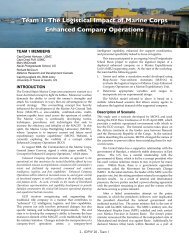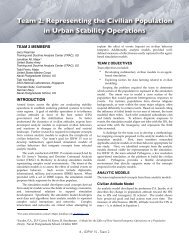pdf file - SEED Center for Data Farming - Naval Postgraduate School
pdf file - SEED Center for Data Farming - Naval Postgraduate School
pdf file - SEED Center for Data Farming - Naval Postgraduate School
You also want an ePaper? Increase the reach of your titles
YUMPU automatically turns print PDFs into web optimized ePapers that Google loves.
Team 14: Anti-Piracy and Terror Reduction<br />
Simulating Pirate Behavior to Exploit Environmental In<strong>for</strong>mation<br />
TEAM 14 MEMBERS<br />
Leslie Esher, LT USN<br />
Stacey Hall, LT USN<br />
Jim Hansen, PhD<br />
Eva Regnier, PhD<br />
Paul Sanchez, PhD<br />
Dashi Singham, PhD Candidate<br />
Problem<br />
Due to the increase in pirate activity off the coast of<br />
Somalia, the United States military and the combined <strong>for</strong>ces<br />
of the world’s navies are partnering together to defeat these<br />
violent extremists. Piracy has threatened maritime safety and<br />
cost commercial shipping billions of dollars paid in ransom<br />
monies. The Gulf of Aden and the Horn of Africa that were<br />
once safe to transit are no longer, and <strong>for</strong> this reason,<br />
President Obama has issued an executive order to defeat<br />
terrorism in the <strong>for</strong>m of piracy. The Commander of the U.S.<br />
<strong>Naval</strong> Forces Central Command (CENTCOM), U.S. Fifth<br />
Fleet, Combined Maritime Forces (CMF), is responsible <strong>for</strong><br />
the safety, stability, peace, and vital interests of the United<br />
States <strong>for</strong> 2.5 million square miles of water. For the contents<br />
of this paper, the region of geographical concentration has<br />
been on the area that has been the most prevalent to pirate<br />
attacks, Somalia. Combined Task Force 151 (CTF 151) is a<br />
multi-national task <strong>for</strong>ce that is response <strong>for</strong> 1.1 million<br />
square miles of water in the Gulf of Aden and off the coast of<br />
Somalia.<br />
Pirates in this area generally operate from small boats<br />
(skiffs) that have limited survivability at sea in severe<br />
weather conditions; this paper will refer to these conditions<br />
as METOC, (Meteorology and Oceanography) conditions.<br />
High sea state and/or wind speeds make it difficult or nearly<br />
impossible <strong>for</strong> pirates to attempt to board commercial<br />
vessels. The analysis of this paper is to provide insight into<br />
what parameters are most influential in contributing to and<br />
limiting pirate behavior.<br />
In response to the piracy problem, the U.S. <strong>Naval</strong><br />
Oceanographic Office (NAVOCEANO) at Stennis Space<br />
<strong>Center</strong> has been providing a <strong>for</strong>ecasting product, called the<br />
Piracy Per<strong>for</strong>mance Surface (PPS) that uses <strong>for</strong>ecasts of<br />
winds and seas to map the locations that are most conducive<br />
to pirate activity, and incorporates in<strong>for</strong>mation on confirmed<br />
pirate activity in the <strong>for</strong>m of an attack, an attempted attack,<br />
or suspicious activity. The existing product was developed<br />
rapidly to provide support to the operators. NAVOCEANO<br />
is working to improve the model of the relationship between<br />
METOC and pirate activity, and to improve the way the<br />
pirate threat is updated when confirmed piracy activity is<br />
observed.<br />
The overarching research question is: How can the N2/<br />
N6 (Director <strong>for</strong> In<strong>for</strong>mation dominance that comprises<br />
in<strong>for</strong>mation, intelligence, command, and control) contribute<br />
decision-critical in<strong>for</strong>mation to the operators who are<br />
protecting commercial shipping traffic.<br />
By September 2010, a new simulation-based engine will<br />
be implemented to produce the PPSNext. The simulation is<br />
based on a model of pirate behavior (hereafter, CONOPS,<br />
Concept of Operations), combined with <strong>for</strong>ecasts <strong>for</strong> METOC<br />
conditions and intelligence on certain parameters of pirate<br />
behavior, such as whether they operate from land or sea bases<br />
(mother ships) and the number and locations of these bases.<br />
The goal of Team 14 was to provide insight on which<br />
parameters describing pirate CONOPS were the most<br />
important drivers of the map reflecting relative pirate threat<br />
and which have the strongest interaction with METOC<br />
variables. These results would indicate which factors in pirate<br />
CONOPS are most important to include in the model and<br />
which parameters should receive most intelligence resources.<br />
Simulated Pirates and Environment<br />
In the model of pirate CONOPS, the basic strategy is to<br />
depart from a base – either a land-based camp or a sea-based<br />
mother ship – typically a Boston Whaler that has longer<br />
longevity and life expectancy at sea, with a handful of pirates<br />
with a few days’ supplies. The skiff motors to its predetermined<br />
location (latitude and longitude). As illustrated<br />
in Figure 1, the skiff then drifts with the winds and currents<br />
Figure 1: Example of a pirate skiff trajectory<br />
50 - IDFW 20 - Team 14




